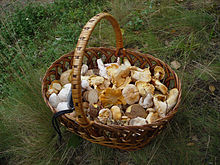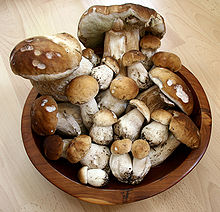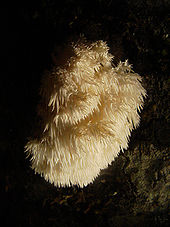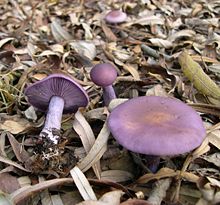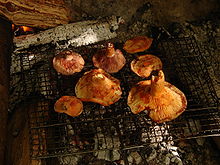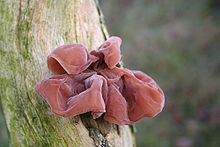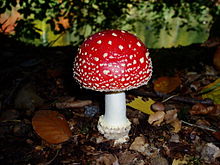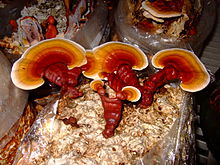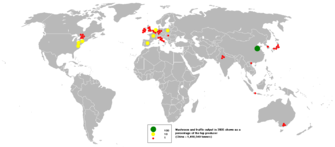- Edible mushroom
-
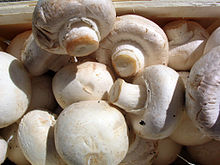 White mushrooms ready for cooking. While common, they are just one of the many types of mushrooms cultivated and eaten.
White mushrooms ready for cooking. While common, they are just one of the many types of mushrooms cultivated and eaten.
Edible mushrooms are the fleshy and edible fruiting bodies of several species of fungi. Mushrooms belong to the macrofungi, because their fruiting structures are large enough to be seen with the naked eye. They can appear either below ground (hypogeous) or above ground (epigeous) where they may be picked by hand.[1] Edibility may be defined by criteria that include absence of poisonous effects on humans and desirable taste and aroma.[2][3] Of the estimated 1.5 million species of fungi, only about 150 are considered toxic.[4]
Edible mushrooms are consumed by humans for their nutritional and occasionally medicinal value as comestibles.[5] Mushrooms consumed for health reasons are known as medicinal mushrooms. While hallucinogenic mushrooms (e.g. Psilocybin mushrooms) are occasionally consumed for recreational or religious purposes, they can produce severe nausea and disorientation, and are therefore not commonly considered edible mushrooms.[5]
Edible mushrooms include many fungal species that are either harvested wild or cultivated. Easily cultivatable and common wild mushrooms are often available in markets, and those that are more difficult to obtain (such as the prized truffle and matsutake) may be collected on a smaller scale by private gatherers. Some preparations may render certain poisonous mushrooms fit for consumption.
Before assuming that any wild mushroom is edible, it should be identified. Proper identification of a species is the only safe way to ensure edibility. Some mushrooms that are edible for most people can cause allergic reactions in some individuals, and old or improperly stored specimens can cause food poisoning. Deadly poisonous mushrooms that are frequently confused with edible mushrooms and responsible for many fatal poisonings include several species of the Amanita genus, in particular, Amanita phalloides, the death cap.
Contents
History of mushroom use
Mycophagy (
 /maɪˈkɒfədʒi/), the act of consuming mushrooms, dates to ancient times. Edible mushroom species have been found in association with 13,000 year old ruins in Chile, but the first reliable evidence of mushroom consumption dates to several hundred years BC in China. The Chinese value mushrooms for medicinal properties as well as for food. Ancient Romans and Greeks ate mushrooms, particularly the upper class.[6] The Roman Caesars would have a food taster taste the mushrooms before the Caesar to make sure they were safe.[citation needed]
/maɪˈkɒfədʒi/), the act of consuming mushrooms, dates to ancient times. Edible mushroom species have been found in association with 13,000 year old ruins in Chile, but the first reliable evidence of mushroom consumption dates to several hundred years BC in China. The Chinese value mushrooms for medicinal properties as well as for food. Ancient Romans and Greeks ate mushrooms, particularly the upper class.[6] The Roman Caesars would have a food taster taste the mushrooms before the Caesar to make sure they were safe.[citation needed]Mushrooms are also easily preserved, and historically have provided additional nutrition over winter.[citation needed]
Many cultures around the world have either used or continue to use psilocybin mushrooms for spiritual purposes as well as medicinal mushrooms in folk medicine. Mushroom cultivation reached the United States in the late 1800s with imported spores from Mexico.[citation needed]
Current culinary use
A fraction of the many fungi consumed by humans are currently cultivated and sold commercially. Commercial cultivation is important ecologically, as there have been concerns of depletion of larger fungi such as chanterelles in Europe, possibly because the group has grown so popular yet remains a challenge to cultivate.
Commercially cultivated
 Commercial cultivated Japanese edible mushroom species. Clockwise from left, enokitake, buna-shimeji, bunapi-shimeji, king oyster mushroom and shiitake.
Commercial cultivated Japanese edible mushroom species. Clockwise from left, enokitake, buna-shimeji, bunapi-shimeji, king oyster mushroom and shiitake.
Mushroom cultivation has a long history, with over twenty species commercially cultivated. Mushrooms are cultivated in at least 60 countries[7] with China, the United States, Netherlands, France and Poland being the top five producers in 2000.
Commercially harvested wild edibles
Some species are difficult to cultivate; others (particularly mycorrhizal species) have not yet been successfully cultivated. Some of these species are harvested from the wild, and can be found in markets. When in season they can be purchased fresh, and many species are sold dried as well. The following species are commonly harvested from the wild:
- Boletus edulis or edible Boletus, native to Europe, known in Italian as Fungo Porcino (plural 'porcini') (Pig mushroom), in German as Steinpilz (Stone mushroom), in Russian as "white mushroom", in Albanian as (Wolf mushroom) and in French the cèpe. It also known as the king bolete, and is renowned for its delicious flavor. It is sought after worldwide, and can be found in a variety of culinary dishes.
- Cantharellus cibarius (The chanterelle), The yellow chanterelle is one of the best and most easily recognizable mushrooms, and can be found in Asia, Europe, North America and Australia. There are poisonous mushrooms which resemble it, though these can be confidently distinguished if one is familiar with the chanterelle's identifying features.
- Cantharellus tubaeformis, the tube chanterelle or yellow-leg
- Clitocybe nuda - Blewit (or Blewitt)
- Cortinarius caperatus the Gypsy mushroom (recently moved from genus Rozites)
- Craterellus cornucopioides - Trompette du Mort or Horn of Plenty
- Grifola frondosa, known in Japan as maitake (also "hen of the woods" or "sheep’s head"); a large, hearty mushroom commonly found on or near stumps and bases of oak trees, and believed to have Macrolepiota procera properties.
- Gyromitra esculenta this "False morel" is prized by the Finns. This mushroom is deadly poisonous if eaten raw, but highly regarded when parboiled (see below).
- Hericium erinaceus, a tooth fungus; also called "lion's mane mushroom."
- Hydnum repandum Sweet tooth fungus, hedgehog mushroom, urchin of the woods
- Lactarius deliciosus Saffron milk cap - Consumed around the world and prized in Russia
- Morchella species, (morel family), morels belong to the ascomycete grouping of fungi. They are usually found in open scrub, woodland or open ground in late spring. When collecting this fungus, care must be taken to distinguish it from the poisonous false morels, including Gyromitra esculenta.
- Morchella conica var. deliciosa
- Morchella esculenta var. rotunda
- Tricholoma matsutake the Matsutake, a mushroom highly prized in Japanese cuisine.
- Tuber species, (the truffle), Truffles have long eluded the modern techniques of domestication known as trufficulture. Although the field of trufficulture has greatly expanded since its inception in 1808, several species still remain uncultivated. Domesticated truffles include
- Tuber borchii
- Tuber brumale
- Tuber indicum - Chinese black truffle
- Tuber macrosporum - White truffle
- Tuber mesentericum - The Bagnoli truffle[8]
- Tuber uncinatum - Black summer truffle
Other edible wild species
Many wild species are consumed around the world. The species which can be identified "in the field" (without use of special chemistry or a microscope) and therefore safely eaten vary widely from country to country, even from region to region. This list is a sampling of lesser-known species that are reportedly edible.
- Amanita caesarea (Caesar's Mushroom)
- Armillaria mellea
- Boletus badius
- Boletus elegans
- Chroogomphus rutilus (pine-spikes or spike-caps)
- Calvatia gigantea (Giant Puffball)
- Clavariaceae species (coral fungus family)
- Clavulinaceae species (coral fungus family)
- Coprinus comatus, the Shaggy mane. Must be cooked as soon as possible after harvesting or the caps will first turn dark and unappetizing, then deliquesce and turn to ink. Not found in markets for this reason.
- Cortinarius variecolor
- Fistulina hepatica (beefsteak polypore or the ox tongue)
- Hygrophorus chrysodon
- Lactarius salmonicolor
- Lactarius subdulcis (mild milkcap)
- Lactarius volemus
- Laetiporous sulphureus (Sulphur shelf). Also known by names such as the "chicken mushroom", "chicken fungus", sulphur shelf is a distinct bracket fungus popular among mushroom hunters.
- Leccinum aurantiacum (Red-capped scaber stalk)
- Leccinum scabrum (Birch bolete)
- Lepiota procera
- Macrolepiota procera Parasol Mushroom - Globally, it is widespread in temperate regions
- Polyporus squamosus (Dryad's saddle and Pheasant's back mushroom)
- Polyporus sulphureus
- Polyporus mylittae
- Ramariaceae species (coral fungus family)
- Rhizopogon luteolus
- Russula, some members of this genus are edible.
- Sparassis crispa. Also known as "cauliflower mushroom".
- Suillus bovinus
- Suillus luteus
- Suillus tomentosus
- Tricholoma terreum
Conditionally edible species
There are a number of fungi that are considered choice by some and toxic by others. In some cases, proper preparation can remove some or all of the toxins.
- Amanita muscaria is edible if parboiled to leach out toxins.[9] Fresh mushrooms cause vomiting, twitching, drowsiness, and hallucinations due to the presence of muscimol. Although present in A. muscaria, ibotenic acid is not in high enough concentration to produce any physical or psychological effects unless massive amounts are ingested.
- Coprinopsis atramentaria is edible without special preparation. However, consumption with alcohol is toxic due to the presence of coprine. Some other Coprinus spp. share this property.
- Gyromitra esculenta is eaten by some after it has been parboiled; however, mycologists do not recommend it. Raw Gyromitra are toxic due to the presence of gyromitrin, and it is not known if all of the toxin can be removed by parboiling.
- Lactarius spp. - Apart from Lactarius deliciosus which is universally considered edible, other Lactarius spp. that are considered toxic elsewhere in the world are eaten in Russia after pickling or parboiling.[10]
- Verpa bohemica - Considered choice by some, it even can be found for sale as a "morel", but cases of toxicity have been reported. Verpas contain toxins similar to gyromitrin[11] and similar precautions apply.
Medicinal use
Medicinal mushrooms are mushrooms or extracts from mushrooms that are used or studied as possible treatments for diseases. Research has shown some medicinal mushroom isolates that have promising cardiovascular, anticancer, antiviral, antibacterial, antiparasitic, anti-inflammatory, and antidiabetic properties. Currently, several extracts (polysaccharide-K,[12] polysaccharide peptide,[13] lentinan[1]) have widespread use in Japan, Korea and China, as adjuvants to radiation treatments and chemotherapy.[14][15]
The concept of a medicinal mushroom has a history spanning millennia in parts of Asia.[2][3] Only a few mushroom extracts have been extensively tested for efficacy. The available results for most other extracts, are on isolated cell lines, animal research with rodents, or underpowered clinical human trials.[15] Although medicinal molds do not produce mushrooms, these fungi were the original source of penicillin, the first statins, and griseofulvin.
Preparing wild edibles
Some wild species are toxic, or at least indigestible, when raw. As a rule all wild mushroom species should be cooked thoroughly before eating. Many species can be dried and re-hydrated by pouring boiling water over the dried mushrooms and letting them steep for approximately 30 minutes. The soaking liquid can be used for cooking as well, provided that any dirt at the bottom of the container is discarded.
One recipe for Auricularia auricula-judae is to collect it while still soft, wash it thoroughly and cut it into thin slices. The prepared slices should be stewed in stock or milk for around three-quarters of an hour, and then served with plenty of pepper. The result is crispy and not unlike seaweed.[16]
The difficult task of identifying mushrooms in the wild, for culinary or recreational purposes, can produce severe poisoning.[17]
Production
Top ten mushroom and truffle producing countries in 2008 Country Output in tons Percentage of total world output China 1,608,219 45.89 United States 363,560 10.40 Netherlands 240,000 6.86 Poland 180,000 5.15 France 150,450 4.30 Spain 131,974 3.77 Italy 100,000 2.86 Canada 86,946 2.49 Ireland 75,000 2.14 Japan 67,000 1.92 WORLD 3,497,290 100.00 Source: FAOSTAT
Vitamin D
Name Chemical composition Structure Vitamin D2 ergocalciferol (made from ergosterol) 
Vitamin D3 cholecalciferol (made from 7-dehydrocholesterol in the skin). 
Mushrooms that have been exposed to ultraviolet (UV) light contain large amounts of vitamin D2.[18][19][20] Mushrooms, when exposed to UV light, convert ergosterol, a chemical found in large concentrations in many mushrooms, to vitamin D2. This is similar to the reaction in humans, where Vitamin D3 is synthesized after exposure to UV light.
Testing conducted by the Pennsylvania State University showed an hour of UV light exposure made a serving of mushrooms contain twice the U.S. Food and Drug Administration's daily recommendation of vitamin D. Testing by the Monterey Mushrooms Company demonstrated 5 minutes of UV light exposure made a serving of mushrooms contain four times the FDA's daily recommendation of vitamin D.[18] High performance liquid chromatography analysis has also demonstrated the effect sunlight has on mushroom vitamin D2 content.[21]
The ergocalciferol, vitamin D2, in UV-irradiated mushrooms is not the same form of vitamin D as is produced by UV-irradiation of human skin or animal skin, fur, or feathers (cholecalciferol, vitamin D3). Although vitamin D2 clearly has vitamin D activity in humans and formerly was widely used in milk fortification and in nutritional supplements, vitamin D3 is often used in dairy products.[22][23] However, any difference in vitamin D bioavailability from the two forms has been adequately disproved to allow reasonable assumption that D2 and D3 are equal for maintaining 25-hydroxyvitamin D status.[24]
Mushroom Sunlight exposure Vitamin D2 content (IU/100g) Shiitake None 10 — 100 Shiitake Gills down 11,000 Shiitake Gills up 46,000 Reishi None 66 Reishi Gills up 2,760 Maitake None 460 Maitake Gills up 31,900 See also
References
- ^ Chang, Shu-Ting; Phillip G. Miles (1989). Mushrooms: cultivation, nutritional value, medicinal effect, and Environmental Impact. CRC Press. pp. 4–6. ISBN 0-8493-1043-1. http://books.google.com/?id=XO4EGzpp1M0C&printsec=frontcover.
- ^ Arora D (1986). Mushrooms demystified. Ten Speed Press. p. 23. ISBN 0-89815-169-4.
- ^ Mattila P, Suonpää K, Piironen V. (2000). "Functional properties of edible mushrooms". Nutrition 16 (7–8): 694–6. doi:10.1016/S0899-9007(00)00341-5. PMID 10906601.
- ^ http://www.einstein.yu.edu/uploadedfiles/casadevall/2005/4.pdf
- ^ a b Boa E (2004). Wild edible fungi: A global overview of their use and importance to people. Food and Agriculture Organization of the United Nations. ISBN 92-5-105-157-7.
- ^ Boa, Eric (2004). "Wild Edible fungi a global overview of their use and importance to people". FAO Corporate Document Repository. http://www.fao.org/docrep/007/y5489e/y5489e05.htm#P138_20454. Retrieved 2008-09-20.
- ^ John Fereira. "U.S. Mushroom Industry". Usda.mannlib.cornell.edu. http://usda.mannlib.cornell.edu/MannUsda/viewDocumentInfo.do?documentID=1395. Retrieved 2010-05-30.
- ^ T. mesenterium was first reported in Great Britain after the wet August 2008 ((BBC News) " New fungi species unearthed in UK", 9 October 2008: accessed 9 October 2008.
- ^ Rubel, William. Amanita Muscaria
- ^ Arora, David. Mushrooms Demystified, 2nd ed. Ten Speed Press, 1986
- ^ FDA IMPORT ALERT IA2502[dead link]
- ^ "Coriolus Versicolor". About Herbs, Botanicals & Other Products. Memorial Sloan-Kettering Cancer Center. http://www.mskcc.org/mskcc/html/69194.cfm.
- ^ Ng, T. B. (1998). "A review of research on the protein-bound polysaccharide (polysaccharopeptide, PSP) from the mushroom Coriolus versicolor (basidiomycetes: Polyporaceae)". General Pharmacology: the Vascular System 30 (1): 1–4. doi:10.1016/S0306-3623(97)00076-1. PMID 9457474.
- ^ Sullivan, Richard; Smith, John E.; Rowan, Neil J. (2006). "Medicinal Mushrooms and Cancer Therapy: translating a traditional practice into Western medicine". Perspectives in Biology and Medicine 49 (2): 159–70. doi:10.1353/pbm.2006.0034. PMID 16702701.
- ^ a b Borchers, A. T.; Krishnamurthy, A.; Keen, C. L.; Meyers, F. J.; Gershwin, M. E. (2008). "The Immunobiology of Mushrooms". Experimental Biology and Medicine 233 (3): 259–76. doi:10.3181/0708-MR-227. PMID 18296732.
- ^ Mabey, Richard (1984), Food for Free., Pub. Fontana / Collins. ISBN 0-00-633470-9. P. 54.
- ^ Barbee G, Berry-Cabán C, Barry J, Borys D, Ward J, Salyer S (2009). ECC1ED5314DF17993B4B357234FB1F8D?issue=20090502 "Analysis of mushroom exposures in Texas requiring hospitalization, 2005-2006". Journal of Medical Toxicology 5 (2): 59–62. doi:10.1007/BF03161087. PMID 19415588. http://jmt.pennpress.org/strands/jmt/toc.htm;jsessionid= ECC1ED5314DF17993B4B357234FB1F8D?issue=20090502.
- ^ a b Bowerman S (March 31, 2008). "If mushrooms see the light". Los Angeles Times. http://articles.latimes.com/2008/mar/31/health/he-eat31.
- ^ Koyyalamudi SR, Jeong SC, Song CH, Cho KY, Pang G (April 2009). "Vitamin D2 formation and bioavailability from Agaricus bisporus button mushrooms treated with ultraviolet irradiation". J Agric Food Chem 57 (8): 3351–5. doi:10.1021/jf803908q. PMID 19281276.
- ^ Lee GS, Byun HS, Yoon KH, Lee JS, Choi KC, Jeung EB (March 2009). "Dietary calcium and vitamin D2 supplementation with enhanced Lentinula edodes improves osteoporosis-like symptoms and induces duodenal and renal active calcium transport gene expression in mice". Eur J Nutr 48 (2): 75–83. doi:10.1007/s00394-008-0763-2. PMID 19093162.
- ^ Paul Stamets (2005). Mycelium Running. Berkeley, California: Ten Speed Press. p. 203. ISBN 978-1-58008-579-3. OCLC 262557556.
- ^ Houghton LA, Vieth R (October 2006). "The case against ergocalciferol (vitamin D2) as a vitamin supplement". Am J Clin Nutr 84 (4): 694–7. PMID 17023693.
- ^ Grant WB (November 2006). "Cholecalciferol, not ergocalciferol, should be used for vitamin D supplementation". Age Ageing 35 (6): 645. doi:10.1093/ageing/afl111. PMID 16982666.
- ^ Holick MF, Biancuzzo RM, Chen TC, Klein EK, Young A, Bibuld D, Reitz R, Salameh W, Ameri A, Tannenbaum AD (2008). "Vitamin D2 is as effective as vitamin D3 in maintaining circulating concentrations of 25-hydroxyvitamin D". J Clin Endocrinol Metab 93 (3): 677–81. doi:10.1210/jc.2007-2308. PMC 2266966. PMID 18089691. http://www.pubmedcentral.nih.gov/articlerender.fcgi?tool=pmcentrez&artid=2266966.
External links
Categories:- Edible fungi
- Lists of foods
- Vegan cuisine
- Vegetarian cuisine
Wikimedia Foundation. 2010.

